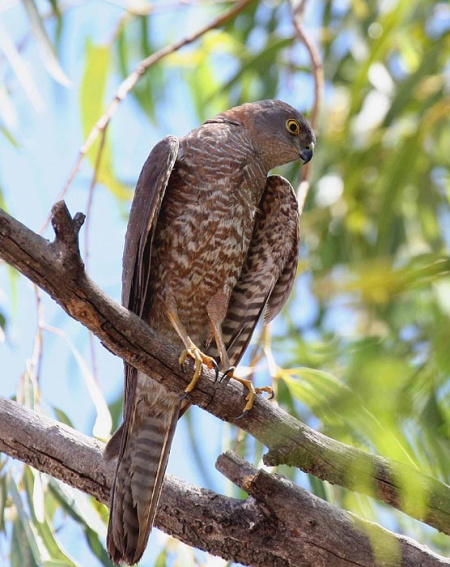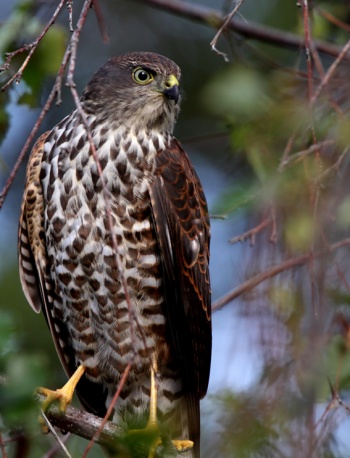Nomdeploom (talk | contribs) m (Add taxonomy category) |
(Genus change. References updated. New combined GSearch. 1 added to GSChecked template) |
||
| (14 intermediate revisions by 10 users not shown) | |||
| Line 1: | Line 1: | ||
| − | + | [[Image:collared_sparrowhawk_bf.jpg|thumb|450px|right|Photo by {{user|Megan+Perkins|Megan Perkins}}<br />Nallan Station, [[Western Australia]], [[Australia]], November 2007]] | |
| − | [[Image: | + | ;[[:Category:Tachyspiza|Tachyspiza]] cirrocephala |
| − | + | ''Accipiter cirrocephalus'' | |
==Identification== | ==Identification== | ||
| + | Length 30-40cm (12-16in.) Wingspan 55-80cm (21.5-31.5in). Females larger<br /> | ||
| + | Grey upper body with chestnut half collar; gray chin, but rest of underbody from chest to tail is finely barred in rufous and white. Long, thin yellow legs. Very long middle toe. | ||
==Distribution== | ==Distribution== | ||
| − | + | Widespread and common throughout [[Australia]] and [[New Guinea]] in appropriate habitat. | |
| − | |||
| − | |||
==Taxonomy== | ==Taxonomy== | ||
| − | ''' | + | The scientific name is also spelled ''cirr'''h'''ocephalus''. |
| − | + | <sup>[[#References|[2]]],[[#References|[3]]]</sup> | |
| + | ====Subspecies==== | ||
| + | [[Image:Sparrowhawk111.jpg|thumb|350px|right|Juvenile<br />Photo by {{user|Weiss1|Weiss1}}<br />Yarraville Gardens, Melbourne, [[Victoria]], [[Australia]], March 2009]] | ||
| + | Two subspecies are recognized<sup>[[#References|[1]]]</sup>. | ||
| + | *''A. c. papuanus'': | ||
| + | :*[[New Guinea]], western [[West Papua|Papuan]] islands and Aru Islands | ||
| + | *''A. c. cirrocephalus'': | ||
| + | :*[[Australia]] and [[Tasmania]] | ||
==Habitat== | ==Habitat== | ||
| + | Forests and fields. | ||
==Behaviour== | ==Behaviour== | ||
| + | ====Diet==== | ||
| + | Expert and fast flyer that typically takes its prey (mostly small birds) in flight. | ||
| + | ====Breeding==== | ||
| + | Its flat nest is built from twigs and sticks, lined with fresh leaves. The female incubates, and broods the young. | ||
| + | ==References== | ||
| + | #{{Ref-Clements6thOct24}}#{{Ref-GillDonskerRasmussen22V12.2}}#Avibase | ||
| + | #Birds in Backyards | ||
| + | {{ref}} | ||
==External Links== | ==External Links== | ||
| − | + | {{GSearch|"Tachyspiza cirrocephala" {{!}} "Accipiter cirrocephalus" {{!}} "Collared Sparrowhawk"}} | |
| − | + | {{GS-checked}}1 | |
| − | [[Category:Birds]] | + | <br /> |
| + | <br /> | ||
| + | |||
| + | [[Category:Birds]] [[Category:Tachyspiza]] | ||
Latest revision as of 01:42, 21 March 2025
- Tachyspiza cirrocephala
Accipiter cirrocephalus
Identification
Length 30-40cm (12-16in.) Wingspan 55-80cm (21.5-31.5in). Females larger
Grey upper body with chestnut half collar; gray chin, but rest of underbody from chest to tail is finely barred in rufous and white. Long, thin yellow legs. Very long middle toe.
Distribution
Widespread and common throughout Australia and New Guinea in appropriate habitat.
Taxonomy
The scientific name is also spelled cirrhocephalus. [2],[3]
Subspecies
Two subspecies are recognized[1].
- A. c. papuanus:
- New Guinea, western Papuan islands and Aru Islands
- A. c. cirrocephalus:
Habitat
Forests and fields.
Behaviour
Diet
Expert and fast flyer that typically takes its prey (mostly small birds) in flight.
Breeding
Its flat nest is built from twigs and sticks, lined with fresh leaves. The female incubates, and broods the young.
References
- Clements, J. F., P. C. Rasmussen, T. S. Schulenberg, M. J. Iliff, T. A. Fredericks, J. A. Gerbracht, D. Lepage, A. Spencer, S. M. Billerman, B. L. Sullivan, M. Smith, and C. L. Wood. 2024. The eBird/Clements checklist of Birds of the World: v2024. Downloaded from https://www.birds.cornell.edu/clementschecklist/download/
- Gill, F, D Donsker, and P Rasmussen (Eds). 2022. IOC World Bird List (v 12.2) DRAFT. Doi 10.14344/IOC.ML.12.2. http://www.worldbirdnames.org/
- Avibase
- Birds in Backyards
Recommended Citation
- BirdForum Opus contributors. (2025) Collared Sparrowhawk. In: BirdForum, the forum for wild birds and birding. Retrieved 9 May 2025 from https://www.birdforum.net/opus/Collared_Sparrowhawk
External Links
GSearch checked for 2020 platform.1





